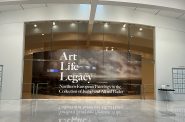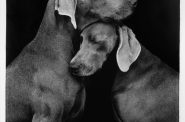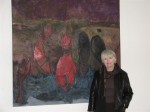Amazing grace at MAM

Rosemarie Koczy (American/Swiss, b. Germany, 1939–2007) Untitled, 1989 Ink on paper 14 x 10 1/2 in. (35.56 x 26.67 cm) Milwaukee Art Museum, Gift of Anthony Petullo M2012.84 Photo credit: Larry Sanders
Forty years ago, when the art therapy craze was fairly new, I enrolled in a course addressing both art as therapy and as diagnostic tool, but had a big problem with the latter. For example, most young boys, given pencil and paper, will at some time in their doodlings draw stick figures with guns and tanks and blasted landscapes. Boys like to depict fires, floods and other disasters. Little girls favor rainbows and hearts. Using a patient’s artwork to diagnose their specific illness struck me as dangerous then strikes me as dangerous now. I began to feel that art exhibitions that showcase mental illness are, by their very nature, offensive.
So I approached MAM’s Accidental Genius: Art from the Anthony Petullo Collection with caution, more so after reading Kat Murrell’s Feb. 10 TCD review. It includes a link to the Gugging Institute, in Austria, a former psychiatric hospital where Nazis once experimented upon (and frequently “euthanized”) those unfortunates who failed to meet the Reich’s standards of perfection. A portion of the institute’s buildings now house a museum operated by Gugging’s former patients.
The words of Jean Dubuffet, who was active in the Art Brut museum, introduce the MAM exhibition: “Art is best when it forgets its very name.” At the gates to the Auschwitz concentration camp are these words: “Work Will Set You Free.” If you think of art as a form of labor (most artists will at least agree it is “work”), then work could be said to have freed the imprisoned soul of Polish artist Rosemarie Koczy. A survivor of a childhood and beyond in death camps, her pen and ink drawings enshrine the memory of concentration camp victims. They shroud (yet protect) the skeletal figures within. Curious isn’t it, that they are both womb-like and tomb-like?

Untitled, 1989 Ink on paper 14 x 10 1/2 in. (35.56 x 26.67 cm) Milwaukee Art Museum, Gift of Anthony Petullo M2012.85 Photo credit: John R. Glembin
Over the years, so much attention has been given to art made by the so-called self-taught that it seems impossible to follow Dubuffet’s advice. Early on, local gallerist Dean Jensen was on the forefront of the stampede for art made by “outsiders.” Prophet William Blackmon, a local street preacher/painter, who died two years ago, was our star. Kent Mueller, who started Metropolitan Gallery in Walker’s Point, plucked Blackmon from the universe. Bob Watt (who died recently, alone and impoverished) was a poet and artist and a friend of Mike Ringo White, who recently showed his work at the Portrait Society Gallery (run by Deb Brehmer, an early supporter of the movement). Jimmy Von Milwaukee ran the infamous Leo Feldman Galleries and often exhibited Ringo’s work. Also, Sheboygan’s John Michael Kohler Art Museum shines on in the self-taught universe.
But outsider art is neither local nor a new phenomenon. Here, there and everywhere, artists work in solitude, creating (often obsessively) whatever it is that turns them on. Accidental Genius isn’t an exhibition about the art of mental patients (though a few were patients at Gugging and elsewhere), nor is it solely about artists working in solitude. Creative diversity, and making something out of nothing, is at the heart of it all.

Untitled, 2005 Ink on paper 14 x 10 11/16 in. (35.56 x 27.15 cm) Milwaukee Art Museum, Gift of Anthony Petullo M2012.97 Photo credit: Tom Bamberger
I wonder how I’d feel had I never heard about “outsider or self-taught” art? These labels are unsettling, perhaps because the exhibition itself is the exact opposite of “solitude.” How long and twisting is the road from point A (the moment of image-making) to point B, when what is (or was) in an artist’s head ends up on the walls of marbled halls, as part of a blockbuster event. For better or for worse, is the work now more Inside than Outside?
But what a collection hath Mr. Petullo assembled. The show is primarily European, but a goodly number of Americans appear, including Mr. Imagination, the creepily marvelous Chicago artist. I had the honor of interviewing him years ago for Art Muscle Magazine. While you are visiting the Petullo collection, don’t miss the Michael and Julie Hall Collection of American Folk Art. It’s been refreshed and brightened up a bit. Bill Hawkins, Mr. Imagination and more add to the intrigue assembled in Windhover Hall. The Petullo exhibition runs through May 6, so there is plenty of time to return again and again.
Get more out of TCD. Check out our FAQ/User Guide.
Art
-
Exhibit Tells Story of Vietnam War Resistors in the Military
 Mar 29th, 2024 by Bill Christofferson
Mar 29th, 2024 by Bill Christofferson
-
See Art Museum’s New Exhibit, ‘Portrait of the Collector’
 Sep 28th, 2023 by Sophie Bolich
Sep 28th, 2023 by Sophie Bolich
-
100 Years Of Memorable Photography
 Sep 18th, 2023 by Rose Balistreri
Sep 18th, 2023 by Rose Balistreri

















Yet another good piece of writing Judith. I wish venues would stop regurgitating the notion of outsider art exhibitions because there have been so many lately within the local community that it’s getting old, overdone. I agree that the idea of exhibiting art showcasing mental illness is dangerous indeed and exploitive.